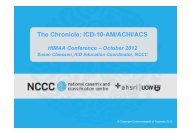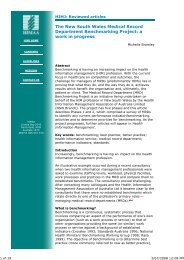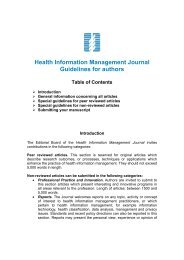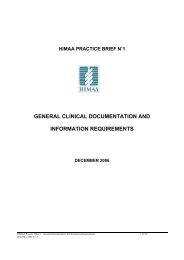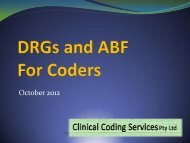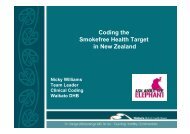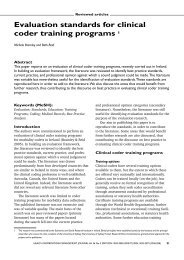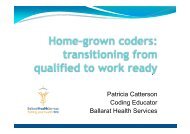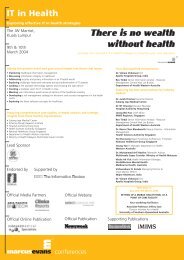Personal Perspectives - Health Information Management ...
Personal Perspectives - Health Information Management ...
Personal Perspectives - Health Information Management ...
Create successful ePaper yourself
Turn your PDF publications into a flip-book with our unique Google optimized e-Paper software.
<strong>Personal</strong> <strong>Perspectives</strong><br />
Introducing<br />
‘<strong>Personal</strong> <strong>Perspectives</strong>’<br />
Welcome to the new <strong>Personal</strong> <strong>Perspectives</strong> section of<br />
our HIM-Interchange (HIM-I). We hope it will become a<br />
forum for some robust discussion and exchange of ideas<br />
for <strong>Health</strong> <strong>Information</strong> Managers (HIMs) and others<br />
grappling with new systems and ways of doing things.<br />
Michelle Martella and Evelyn Robinson have provided<br />
our fi rst piece in this new section, with their overview<br />
of the introduction of a Digitalised Medical Record and<br />
a remote coding service at Barwon <strong>Health</strong>. Michelle and<br />
Evelyn provide a list of requirements for implementation<br />
of successful remote coding and highlight some of the<br />
issues that need to be addressed. Many health services<br />
have already or are in the process of implementing<br />
scanned medical records, which would enable them to<br />
also embark on a process of remote coding. We would<br />
like to hear from HIMs who are involved with these<br />
developments. Have you tried remote coding? If so, does<br />
it work for you? Do you have any thoughts or ideas that<br />
you would like to contribute to this discussion? Author<br />
your own <strong>Personal</strong> Perspective piece or write a Letter<br />
to the Editor of this journal to respond to this or any<br />
other article you read in HIM-I. We look forward to<br />
hearing everyone’s views!<br />
Jennie Shepheard, Editor<br />
INVITATION<br />
Are you planning to attend the HIMAA<br />
Conference in Melbourne in September 2011?<br />
If so, or even if not, but you live in Melbourne you might<br />
like to attend a planning meeting for HIM-Interchange on<br />
Wednesday 21 September (afternoon). HIM-Interchange<br />
is HIMAA’s professional practice journal and attendance<br />
at this meeting will give you an opportunity to<br />
contribute to the future direction of this journal and<br />
obtain some insight into how such a journal gets to<br />
production. More details will be available closer to the<br />
date. Meantime, if you would like to discuss anything<br />
about this meeting please contact me (Kay.Bonello@<br />
healthecare.com.au).<br />
Kay Bonello, Chair, Editorial Board<br />
Clinical coding –<br />
near or far?<br />
Michelle Martella and Evelyn Robinson<br />
In an ideal workplace environment, there would be<br />
an endless supply of skilled human resources on tap,<br />
all of whom work happily onsite in a dynamic and<br />
cohesive team. Of course, there would also be plenty<br />
of office space, complete with window view! However,<br />
reality can be quite different. At Barwon <strong>Health</strong>,<br />
remote coding has proved extremely beneficial to the<br />
organisation, and has helped fill a vital need for scarce<br />
clinical coding resources. Although there have been<br />
challenges along the way, if implemented efficiently,<br />
with good quality checks and key performance indicators<br />
in place plus strong management, remote coding<br />
can be a handy resource in assisting organisations to<br />
meet their needs for clinical coding services, as well as<br />
providing benefits to Clinical Coders themselves.<br />
Barwon <strong>Health</strong> overview<br />
Barwon <strong>Health</strong>, which covers the Barwon region of<br />
south-western Victoria, offers an excellent work environment.<br />
It is the largest employer in the region, with<br />
53,000 Emergency Department presentations annually.<br />
Barwon <strong>Health</strong> uses a unique patient identifier across<br />
its 23 sites. It is comprised of a number of facilities on<br />
these sites, including:<br />
•<br />
•<br />
•<br />
•<br />
The Geelong Hospital (390 acute beds)<br />
McKellar Centre, a rehabilitation and aged care<br />
facility (511 sub-acute and aged-care beds)<br />
Swanston Centre for mental health, drugs and<br />
alcohol services (40 mental health beds)<br />
Regional receiving hospital, servicing 400,000<br />
people across Barwon South West Region<br />
The digital medical record (DMR)<br />
Barwon <strong>Health</strong> uses the digital medical record (DMR),<br />
which is a combination of :<br />
• the electronic health record (EHR), where<br />
information is entered electronically or imported<br />
via external electronic systems<br />
• the scanned medical record, where information is<br />
created using paper, then scanned and archived in<br />
an electronically viewable format<br />
The easiest way to think of the DMR is as ‘digital<br />
storage and viewing’ of a patient’s medical history.<br />
16 HIM-INTERCHANGE Vol 1 No 2 2011 ISSN 1838-8620 (PRINT) ISSN 1838-8639 (ONLINE)
<strong>Personal</strong> <strong>Perspectives</strong><br />
Barwon <strong>Health</strong>’s chosen system is BOSSnet by Core<br />
Medical Solutions.<br />
Remote coding<br />
Remote coding initially commenced at Barwon <strong>Health</strong><br />
because of a pressing need to meet external coding<br />
deadlines, coupled with the statewide shortage of<br />
Clinical Coders. Traditional advertising for both <strong>Health</strong><br />
<strong>Information</strong> Managers (HIMs) and Clinical Coders<br />
was, as many other regional Victorian hospitals have<br />
also found, generally unsuccessful. With the introduction<br />
of the DMR to Barwon <strong>Health</strong> in October 2007,<br />
the opportunity to use those Clinical Coders who<br />
would not otherwise have been available to work in<br />
a regional area, become a reality. Barwon <strong>Health</strong> has<br />
been able to secure skilled resources well beyond the<br />
region, not only in clinical coding, but also in other<br />
areas of health information management.<br />
One of the flow-on benefits of remote coding has<br />
been the opportunity to offer permanent onsite staff<br />
the flexibility to work from home, as needed. To be<br />
in a position to offer staff family-friendly workplace<br />
flexibility has been beneficial; as a consequence of<br />
this situation staff retention rates have improved in a<br />
profession which has a recognised industry shortfall. In<br />
an environment that is bound by deadlines, flexibility<br />
to increase or decrease remote coding services as the<br />
need arises has been invaluable.<br />
To implement successful remote coding, there are<br />
important requirements and other issues which should<br />
not be overlooked:<br />
• the need for detailed planning for implementation<br />
from an IT perspective<br />
• strong orientation of facility-specific systems and<br />
processes<br />
• collaborative recruitment to ensure qualifications<br />
and experience meets own casemix environment<br />
• ongoing quality audits and involvement in<br />
education programs<br />
• clear expectation of quality and throughput key<br />
performance indicators (KPIs)<br />
• employment arrangements (e.g. contractors vs.<br />
permanent remote staff)<br />
• building relationship between internal and external<br />
staff to maintain strong team ethic<br />
• a strong communication plan to address challenges<br />
of non face-to-face communication<br />
• daily challenges of managing a team that is widely<br />
spread out<br />
• knowledge of state-specific coding standards,<br />
editions, advice, admission policy and casemix<br />
• occupational health and safety considerations.<br />
Advances in IT enhance the opportunity for remote<br />
coding, but can also contribute to its demise if not<br />
carefully managed. A robust and secure network<br />
platform is essential, as is a team of IT support staff<br />
who understand the complex needs of a coding<br />
team. The following measures are important for the<br />
successful use of IT sytems in this environment:<br />
• There should be a well-mapped path to setting up<br />
new remote users, who can face greater challenges<br />
than onsite staff; if possible, assign a dedicated IT<br />
support staff member to assist with initial set up.<br />
• Slowness or downtime of systems for various<br />
reasons (individual Internet speed, site-specific<br />
performance) should be covered in contractual<br />
agreements.<br />
• Where possible, plan ahead for system downtime<br />
and upgrades.<br />
• Given remote coders often work out-of-hours,<br />
ensure there is appropriate afterhours IT support.<br />
With the proposed National <strong>Health</strong> Reform and an<br />
already identified national Clinical Coder workforce<br />
shortage, there is a growing need for a remote<br />
workforce, so start the planning early and lead the way<br />
for a smooth and successful remote coding program.<br />
Your organisation and the coding profession as a whole<br />
will benefit.<br />
Michelle Martella<br />
Manager Casemix and Coding Processes<br />
Barwon <strong>Health</strong><br />
1-75 Bellerine Street<br />
Geelong VIC 3220<br />
email: michellem@barwonhealth.org.au<br />
Evelyn Robinson, BBus(HIM)<br />
<strong>Health</strong> <strong>Information</strong> <strong>Management</strong> Consultant<br />
Queensland University of Technology<br />
E&C Consulting Pty Ltd<br />
PO Box 816<br />
Woodend VIC 3144<br />
email: evelynrobinson@yahoo.com.au<br />
•<br />
HIM-INTERCHANGE Vol 1 No 2 2011 ISSN 1838-8620 (PRINT) ISSN 1838-8639 (ONLINE) 17




